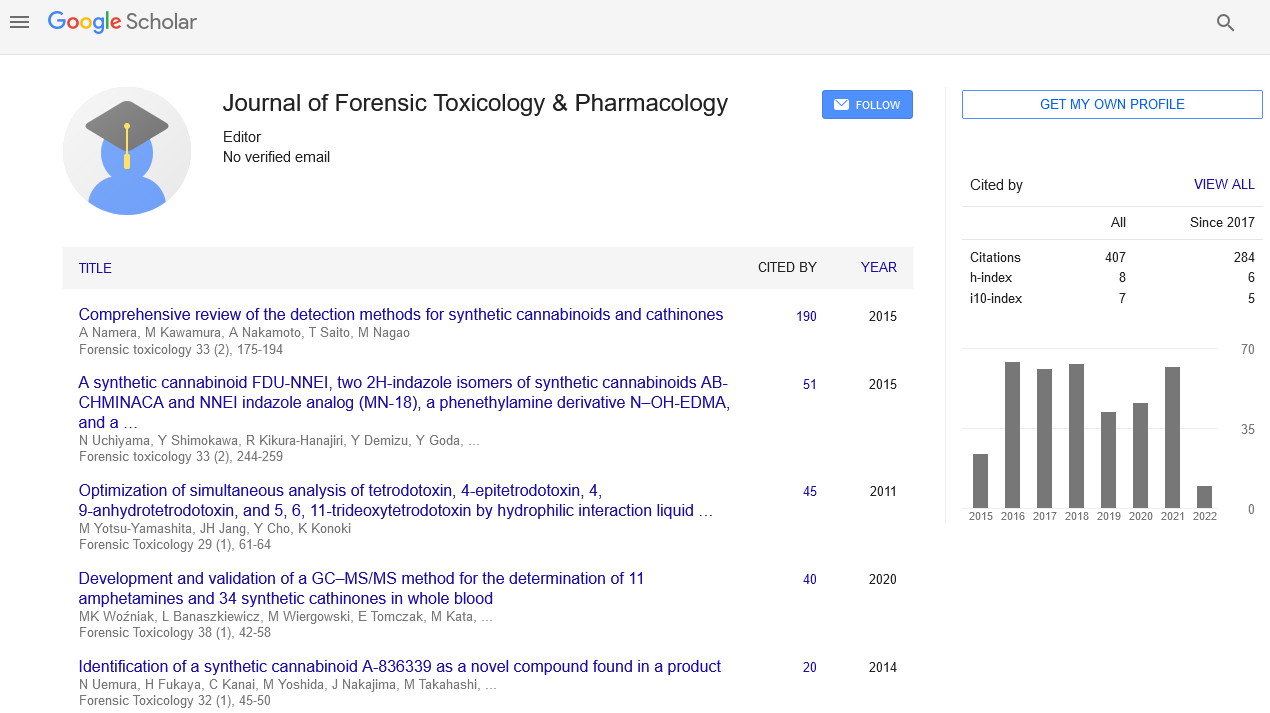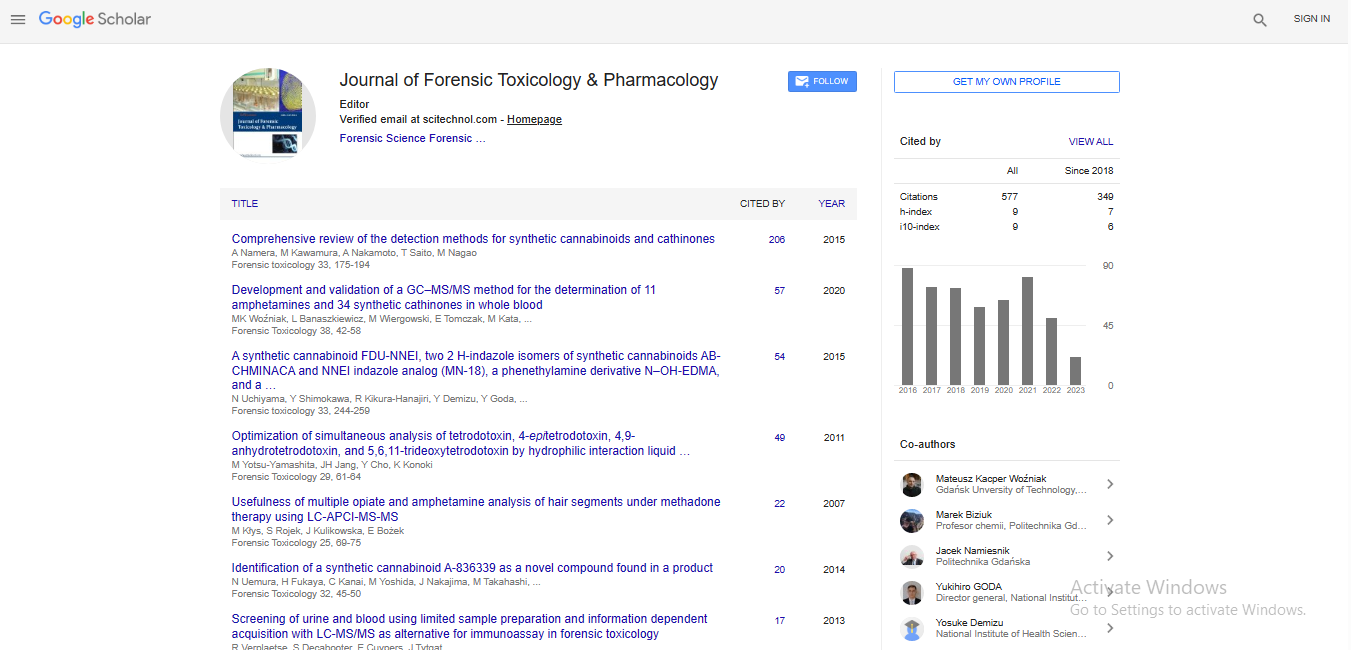Opinion Article, J Forensic Toxicol Pharmacol Vol: 13 Issue: 4
Forensic Analysis of Lethal Toxins in Criminal Cases
Hertz Stahl*
1Department of Pathology and Health Sciences, Stellenbosch University, Stellenbosch, South Africa
*Corresponding Author: Hertz Stahl,
Department of Pathology and Health
Sciences, Stellenbosch University, Stellenbosch, South Africa
E-mail: stahlhertz@gmail.com
Received date: 26 November, 2024, Manuscript No. JFTP-24-156289;
Editor assigned date: 28 November, 2024, PreQC No. JFTP-24-156289 (PQ);
Reviewed date: 12 December, 2024, QC No JFTP-24-156289
Revised date: 19 December, 2024, Manuscript No. JFTP-24-156289 (R);
Published date: 26 December, 2024, DOI: 10.4172/JFTP.1000209.
Citation: Stahl H (2024) Forensic Analysis of Lethal Toxin in Criminal Cases. J Forensic Toxicol Pharmacol 13:4.
Description
The forensic investigation of lethal toxins is a difficult aspect of modern criminal cases, combining scientific precision with legal relevance to resolve complex scenarios involving toxic substances. Lethal toxins, whether chemical, biological, or synthetic, have been weaponized or misused to commit crimes ranging from homicides to acts of terrorism. Forensic toxicology plays a pivotal role in detecting, identifying and interpreting the presence of these toxins, providing important evidence in legal proceedings.
The process of analyzing lethal toxins begins with the collection of biological samples, such as blood, urine, hair, or tissue, from the victim or crime scene. These samples are meticulously handled to prevent contamination and degradation, ensuring the reliability of subsequent analyses. Forensic toxicologists employ advanced analytical techniques, such as Gas Chromatography-Mass Spectrometry (GCMS) and High-Performance Liquid Chromatography (HPLC), to detect and quantify toxic substances. These methods offer high sensitivity and specificity, enabling the identification of even trace amounts of lethal compounds.
In cases involving poisons like cyanide, arsenic, or ricin, rapid detection is often important to understanding the timeline and mechanism of poisoning. Cyanide, for instance, acts quickly by inhibiting cellular respiration, leading to death within minutes or hours. Forensic analysis focuses on measuring cyanide levels in blood or tissues, often correlating them with clinical symptoms or observed evidence at the crime scene. Similarly, arsenic a historically notorious poison can be detected in hair or nails, where it accumulates over time, providing a timeline of exposure.
Biological toxins, such as those derived from plants or microorganisms, present unique challenges in forensic investigations. Ricin, extracted from castor beans, is a potent toxin that inhibits protein synthesis, leading to cell death. Its forensic identification involves immunoassays and Polymerase Chain Reaction (PCR) techniques to detect ricin proteins or related genetic material. Botulinum toxin, another lethal agent, is analyzed using Enzyme- Linked Immunosorbent Assays (ELISA) to confirm its presence in biological or environmental samples. These methods underscore the importance of combining traditional toxicological approaches with molecular biology tools to address the complexity of biological toxins.
Synthetic toxins, including nerve agents like sarin and VX, represent another category of lethal substances with forensic significance. These agents are highly toxic and act by disrupting neurotransmission, causing rapid onset of symptoms and death. Forensic toxicologists analyze samples from exposed individuals using techniques like Liquid Chromatography-tandem Mass Spectrometry (LC-MS/MS) to identify these agents and their metabolites. Environmental samples, such as soil or air, may also be tested to trace the source and spread of contamination.
Interpreting the results of forensic toxin analysis requires a multidisciplinary approach. Toxicologists collaborate with pathologists, chemists and law enforcement to contextualize findings within the broader narrative of the case. Factors such as the victim’s medical history, potential exposure pathways and the presence of other substances are considered to determine causality. This complete analysis ensures that conclusions drawn from toxicological data are scientifically robust and legally admissible.
Forensic analysis of lethal toxins also has implications for public health and safety. Cases involving intentional poisonings or chemical attacks often prompt broader investigations to prevent further incidents. Law enforcement agencies and public health organizations work together to identify patterns, trace the origins of toxins and implement measures to reduce risks. The use of forensic findings in this context demonstrates the societal impact of toxicological research beyond individual cases.
Advancements in analytical technologies continue to enhance the capabilities of forensic toxicology. Portable instruments, such as handheld mass spectrometers, enable on-site detection of toxins, reducing the time required for initial assessments. High-resolution mass spectrometry and next-generation sequencing are expanding the range of detectable substances and providing deeper insights into their mechanisms of action. These innovations are difficult in addressing the evolving challenges posed by emerging toxins and complex crime scenarios.
Ethical considerations are inherent in the forensic analysis of lethal toxins. The potential for misuse of sensitive techniques and data necessitates strict adherence to professional standards and regulatory guidelines. Forensic toxicologists must balance the pursuit of scientific truth with respect for individual rights and public trust. Transparent communication of findings and the limitations of analyses are essential to maintaining credibility and ensuring justice. The forensic analysis of lethal toxins is a cornerstone of criminal investigations, providing indispensable evidence in cases involving poisoning or chemical attacks. Through advanced analytical techniques, interdisciplinary collaboration and ethical practice, forensic toxicologists unravel the mysteries of toxin-related crimes, contributing to justice and public safety. As science and technology continue to evolve, the field remains poised to address new challenges and protect society from the insidious threat of lethal toxins.
 Spanish
Spanish  Chinese
Chinese  Russian
Russian  German
German  French
French  Japanese
Japanese  Portuguese
Portuguese  Hindi
Hindi 
